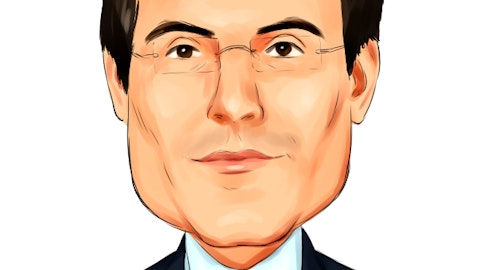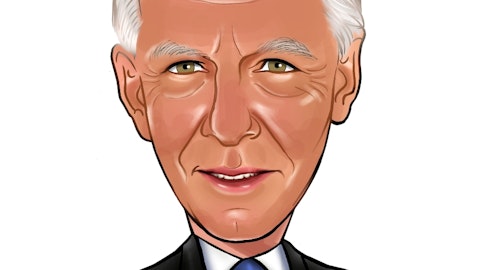Canadian Pacific Railway Limited (NYSE:CP) Q1 2024 Earnings Call Transcript April 24, 2024
Canadian Pacific Railway Limited misses on earnings expectations. Reported EPS is $0.679 EPS, expectations were $0.687. CP isn’t one of the 30 most popular stocks among hedge funds at the end of the third quarter (see the details here).
Operator: Good morning. My name is James, and I will be your conference operator today. At this time, I would like to welcome everyone to CPKC’s First Quarter 2024 Earnings Conference Call. The slides accompanying today’s call are available at investor.cpkcr.com. All lines have been placed on mute to prevent any background noise. After the speakers’ remarks, there will be a question-and-answer session. [Operator Instructions] I would now like to introduce Chris de Bruyn, Vice President, Capital Markets, to begin the conference.
Chris de Bruyn: Thank you, James. Good morning, everyone, and thank you for joining us today. Before we begin, I want to remind you this presentation contains forward-looking information. Actual results may differ materially. The risks, uncertainties, and other factors that could influence actual results are described on Slide 2, and in the press release, and then MD&A filed with Canadian and US regulators. This presentation also contains non-GAAP measures outlined on Slide 3. Please note, in addition to our regular quarterly financials, there is supplemental Q1 combined revenue and operating performance data available at investor.cpkcr.com, which some of today’ discussion will focus on. With me here today is Keith Creel, our President and Chief Executive Officer; Nadeem Velani, our Executive Vice President and Chief Financial Officer; John Brooks, our Executive Vice President and Chief Marketing Officer; and Mark Redd, our Executive Vice President and Chief Operating Officer.
The formal remarks will be followed by Q&A. In the interest of time, we would appreciate if you limit your questions to one. It is now my pleasure to introduce our President and CEO, Mr. Keith Creel.
Keith Creel: Good morning. Thanks, Chris. Listen, before we get to the results, I think it’s only appropriate on behalf of our CPKC family to extend our heartfelt prayers and condolences to Jim Foote’s family and friends. As many of you know, we lost Jim last week. Many of us in this industry have had the honor to serve with Jim during his multiple decades of service to this industry. I can tell you myself personally, I’m going to cherish the memories and the experiences. He’s a wonderful man, a dedicated man, dedicated to this industry, dedicated to the railroads that he worked for and the people that he served with. If you knew him, there are a couple of things that are undeniable about him. He loved his friends, he loved his family, and he loved the companies that he served and he loved this industry.
It’s a man loss too soon. I can tell you he left it better. The memories and the experiences will not be forgotten nor will Jim nor will his impact on this industry. So all the best again to his family prayers and condolences. So with that said, I want to thank you for joining us on the call today as we get to share our results. As I always will, I want to start my comments thinking the 20,000 strong family of railroaders that enable the results that we get to share today. As you’re all aware, we just celebrated our one year anniversary just last week of this historic combination. We’re here to celebrate actually today in Calgary another historic event. We’re going to launch our final spike steam tour this afternoon. So super exciting day in Calgary after we get to share these results and do our AGM, we get to celebrate with our employees and start this historic and iconic trip across all three nations.
So for the next probably 35, 40 days, we’re going to get to spend time and thank the communities that we’re operating in through all the way from Calgary down to Mexico City. So I think the employees again that have been specifically involved in enabling this creation, this vision we created two years ago with the culmination of the launch today. So thank you for that. And I hope any of you across this network will have a chance to participate in that. So, looking back this last year of our forever story, I tell you I can’t be more pleased with the progress. We’re delivering on the commitments we made to create competition. We’re delivering a safe and efficient service and we’re expanding our service continually. We’re creating new and expanded customer relationships over the new markets that we’re creating, collaborating that is only enabled because of this historic combination.
I’m pleased with the results we produced in the quarter. It’s been a strong start to the year from an RTM and an operational perspective. Yes, it was a tough January, but I can tell you, Mark and the operations team recovered quickly and the bonds have exceeded the expectations that we provided during our Q4 earnings call. So specific to the results, the first quarter produced revenues of $3.5 billion which is an increase of 2% and operating ratio of 64% which is about 50 bps increased versus last year, core EPS of $0.93 an increase of 3%. Despite a challenging start from the year, the volumes finished up 1% for the quarter. On the operating performance, I’m extremely pleased with how the network bounced back from the January challenges and the resiliency that the team displayed, the momentum that we created in the quarter with strong gains across the network and speed well on locomotive productivity.
The improvements were pronounced in Mexico where we continue to see large improvements across our operating metrics. Several of the key metrics that we follow internally have improved significantly in Mexico this quarter. Car Miles per Car Day, locomotive productivity both up over 20% year-over-year. Active cars online down 15%, well down, productivity improving. The gains we’ve made in Mexico, they improved velocity, they’ve allowed us to optimize our asset base, we’ve been able to park assets, we’ve been able to redeploy as many as 60 locomotives in fact during the quarter to other parts of the network to address winter weather and serve stronger than expected demand. The huge credit to the operating team demonstrating the power of a true precision scheduled railroading operating model.
In fact, I think it’s better said that CPKC is PSR Prime. And importantly, these improvements continue to come at a time that in Mexico we’re delivering an all-time highly GTM performance. Some animate change, as you would have seen in March, we made a change to our leadership team in releasing John Orr from his commitments to CPKC. Again, I’d like to thank John for his contributions and the impactful leadership that he had. As a leader, I believe it’s your challenge to leave it better and John did that. He did that in his service to the KCS while the company was in trust as well as to CPKC until its departure just last month. We’re fortunate to have an extremely talented and deep bench of PSR railroaders on our team. So the decision to release John was not an easy one, but it was made possible by the strength and the depth of the teams we actually have at CPKC.
The plan was always for the Mexican operations to eventually report into Mark as our COO. And with the strong performance in Mexico that I’ve mentioned, the experienced team that we have in place, it just simply made sense to accelerate that plan. So credit to the entire operation team since John’s departure, they haven’t missed the beat. We’re continuing to execute, drive improvements and provide great customer service to our customers. So in closing, I’m happy to start I’m happy with the start that we’ve had to the year, our performance so far in the second quarter as well. We’re poised to be the most relevant rail network in North America uniting a continent, adding competition to the industry and delivering new options along with safe and efficient service to our customers.
So with that said, I’m going to hand it over to Mark to speak to the operating performance. John is going to bring some color to the markets, and then Nadeem will close elaborating on the numbers before we open it up to questions. Over to you, Mark.
Mark Redd : All right. So thank you, Keith, and good morning. I’m extremely proud of the operating team produced this quarter. I’d like to thank them for their continued work, hard work delivering safe or reliable service. Throughout the quarter, I spent a great deal of time on the network and I’m pleased with the level of talent and dedication here at CPKC. I’d like to recognize the Shreveport terminal as well. They were named CPKC’s 2023 Terminal of the Year. This terminal has been executing at an extremely high level. And having spent time early in my career at this terminal, I’m very pleased to recognize this team for their outstanding achievement. Also spent time in New Mexico this quarter. We have had a strong dedicated team of experienced railroaders.
And as Keith noted, we’re continuing to drive strong sustainable improvements. Now looking at the quarter, thanks to the team’s collective efforts, we made a quick full recovery of extended cold weather in January serving very strong volumes in the western corridor and also extreme high level record GTMs in Mexico. We’re oppose the strong year-over-year operating metrics. And looking at the metrics this morning, locomotive productivity up 8%, average trends data 13% and our dwell is 10% down all to demonstrate a fluid network. Our fuel efficiency declined 2% largely due to the weather earlier in the quarter, but expect this to improve throughout the year. So looking at safety this morning, the FRE personal injury is up 3% year-over-year at a 1.15%.
FRA train accident still leading the industry at 0.89, up from 0.71 a year ago. While we strive for expected improvement each quarter, safety is a never ending journey. Our focus remains on building an aligned safety culture, which is key to maintaining CPK’s industry leading safety record. Notably, we’ve rolled out Home Safe across the KCS network and we continue to do so in Mexico as well. So as I look at Mexico we’re advancing some of the key initiatives have identified last year to improve productivity and capacity. We’re finding opportunities to streamline our operations during the quarter, we were able to shut down switching operations at the Vegas yard. We’re also focused on improving cycle times, streamlining operations for both commodities and customers.
This is an area where we’ve seen success so far, but we’re also freeing up locomotives and equipment that we can use in other parts of the network so we can create more synergies and handle more growth. Looking at capital, our plan of our loans remains focused on growth and safety. In the quarter, we in serviced 3 more new siding as part of our $275 million capital — merger capital commitment. We’ve also in serviced 2 sidings in Mexico to help with capacity and fluidity. If we look at the Laredo Bridge, 65% complete at this point, remain on target to be in to close out by the end of the year. All of these projects will support growth and further improvement in the network. In summer, we’ve had a great start to the year and entire network is in great shape.
We’re in a good place from an asset and resource perspective and the team is now on focusing providing service excellence to generate industry leading growth. And with that, I’ll pass it over to John.
John Brooks : All right. Thank you, Mark, and good morning, everyone. So with the full year as a combined company under our belt, I’m extremely pleased with the progress we’ve made so far and all the opportunities I still see ahead of us. We’ve built on our momentum from Q4 and despite some of the early weather challenges we had to start the year, we have started the year strong and we are gaining momentum. Now looking at the results, on a combined basis, we delivered freight revenue growth of 1% on 1% RTM growth. This is slightly ahead of the flat to slightly down outlook for RTMs that we provided to the market in January. Sense per RTM was flat year-over-year with strong pricing offset by a 3% fuel headwind along with negative mix.

Carloads on the quarter were down 3% and I fully expect carloads to continue to lag RTMs. This is a result of our network unlocking longer lengths of haul as shippers take advantage of our seamless 3 country franchise delivering RTM growth in average length of haul on the quarter up 8% versus last year. In addition, we’ve also seen lower margin short haul intermodal business running between Mexico and the border shift off our network opening up further capacity for growth in our strategic long haul lanes. Now taking a closer look at our first quarter revenue performance, I’ll speak to the FX adjusted results on a comparison versus CPKC had the combination occurred in 2023. Starting with bulk, grain revenues were up 2% on 1% RTM growth. U.S. grain volumes grew 19% over prior year.
Our franchise is benefiting from strong export corn shipments to the P&W and Alberta, along with more shipments of wheat and soybeans to Mexico, which is a new area of growth for TPKC. Canadian grain volumes were down 15% year-over-year. Volumes decreased as a result of a weaker 2023 harvest in our However, they still came in better than anticipated as on farm supplies remained stronger given softer shipping in the fall peak. So while we may see better than expected volumes this summer, we still expect overall year-over-year compares in Canadian grain to be a headwind until we get to the new crop. I also should note that the strong performance in our U.S. grain franchise essentially offset the Canadian grain headwind and this is a great example of how this combined network is adding resiliency within our book of business.
Moving on to potash, revenues were up 4% on a 2% volume growth. Despite a very slow start in January, we rebounded quickly and ended the quarter with growth driven by solid export and domestic shipments. We are well position for solid potash growth in 2024 as demand remains steady and we lap the comps from Canpotex outage at their Portland terminal that occurred from April to December of last year. Coal revenue and volume declined 7%. Cold weather in January negatively impacted Teck’s production and exports while lower natural gas prices weakened demand for U.S. Coal. We expect a good run with tech as we look to clawback tonnage that didn’t move in Q1. Now moving on to merchandise, Energy Chemicals Plastics revenue and volume grew 2%. The volume growth in the quarter was driven by higher fuel oil, DRU shipments and plastics.
This strength was partially offset by multiple customer outages we faced resulting from the cold weather. Looking at this portfolio, we are excited about the synergies that we are capturing particularly with new wins in plastics, renewable diesel and refined fuels as we connect the markets between Alberta, the Gulf Coast and Mexico. Looking forward, with customer production now stabilized at our facilities on our network and the ongoing ramp up of synergy gains, we are set up for a solid year in ECP. For forest products, revenues were down 4% on flat volumes. Forest products volumes were flat despite the broader economic headwinds we all face and softening in the paper space. We had a record quarter in lumber driven by strong synergy conversions with new line haul solutions connecting Canadian producers with the strong demand in the Texas market.
The metals, minerals and consumer products revenue was down 1% on a 5% volume decline. Volumes in the quarter were largely impacted by weakness in frac sand to the Bakken and Permian Basins. This was partially offset by ongoing strong demand from our steel production. Automotive produced another record quarter with volumes up 8% and revenues up 10%. Despite this record performance, I was not pleased. Results came in well below our expectations due to numerous production holds for quality and parts availability. With those issues largely resolved, we expect to see growth in automotive continue to accelerate through Q3 and the rest of the year. I’m also very excited to have our new Dallas Auto Compound opening in June located at our Wylie terminal.
This compound is part of our playbook that unlocks an entirely new supply chain model for the OEMs giving them the service, reliability and capacity certainty like they’ve never seen before. I’m proud to report that this new compound is largely sold out and will handle many of the top selling vehicles within the Texas market, including the vehicles built by our anchor tenant General Motors. On the intermodal side, revenue was down 1% on 7% volume growth. Starting with the international intermodal, volumes were up 14% on strong growth through both the ports of Vancouver and Lazaro. Strength through Vancouver was driven by a return of volumes after the work stoppage last summer and some impacts from the Red Sea and potential looming East Coast labor disruptions.
Although these stronger than forecasted volumes did drive some temporary congestion at the port. We successfully work with our customers and the port to manage this excess volume. We are also encouraged by the ongoing trends at the port of Lazaro Cardenas. Through February, TEUs through this terminal grew by over 40% year-over-year. In domestic intermodal, volumes were flat this quarter. Our Mexico Midwest Express cross-border service continues to perform extremely well with truck like service across a safe reliable border in Laredo. Growth on this flagship service has helped to offset the shift in the short haul business and since February, we have seen weekly volumes grow by over 24%. We expect our density on this product to build through the year as we grow our volumes of reefer traffic between U.S. and Mexico.
And pending STB approval, we start up operations with CSX and Schneider from Texas and Mexico into the Southeast U.S. So in closing, Q1 volumes came in better than expected and we’re off to a good start in Q2. Looking at the past 7 months, we’ve seen year-over-year volume growth in each month excluding January. While we still have a headwind from Canadian grain and we continue to be very cautious on the macro environment, our line of sight to synergies, self-help opportunities and a disciplined pricing approach remains a unique opportunity for CPKC. I’m pleased with what we have accomplished for our first year as a combined company, and I look forward to sharing continued progress with you as we go forward. With that, I’ll pass it to Nadeem.
Nadeem Velani : All right. Thanks, John, and good morning. So looking at the numbers, our reported operating ratio was 67.4% and the core adjusted combined operating ratio came in at 64%. Earnings per share was $0.83 and core adjusted combined earnings per share was $0.93 up 3% year-over-year. As a reminder, these core adjusted earnings exclude the non-cash impact of purchase accounting for the KCS merger, primarily related to D&A. Along with interest expense and acquisition related costs, which continue to gradually decline. Similar to what we shared last quarter, our combined operating expenses illustrate the effects of the acquisition for the first quarter as if the acquisition closed on January 1, 2022. I’ll speak to FX adjusted combined operating results in these prepared remarks.
Now taking a closer look at our income statement, reported operating expense is provided on Slide 13 and combined operating expenses on Slide 14, where I will focus my comments. Excluding adjustments, comp and benefits expense was $676 million. The increase was driven by wage and benefit inflation along with the $23 million headwind from stock-based compensation, driven by the increase in share price over the course of the quarter. Stock comp amounted to a 70 basis point or $0.01 headwind on the year. We also saw higher current service costs from our DB pension plan of $4 million due to a lower discount rate at year-end 2023. Looking to the rest of 2024, we continue to expect average headcount to be roughly flat on a year-over-year basis. Fuel expense was $458 million down 5%.
The decline was primarily driven by a $28 million or 6% decline in fuel price. Overall, net fuel price was a $61 million drag to operating income in the quarter or about an 80 basis point impact to the OR. This amounted to a $0.05 headwind as well to core adjusted combined earnings on the quarter. Materials expense was down 5%. The decline in the quarter was driven primarily by timing of track and locomotive maintenance as activity schedules across the legacy CP and legacy KCS network are aligned. Equipment rents were up $12 million or 17%. The increase was due to a 2023 receivable along with higher intermodal car hire as CPKC lanes shift to longer lengths of haul. This increase was partially offset by higher efficiency from improved cycle times and increased network velocity.
The depreciation expense was up 6% resulting from a higher asset base. Purchased services and other was up 2% year-over-year, higher terminal service costs and increase in bad debt expense and cost inflation were partially offset by cost synergy savings from the combined insurance premiums and the recognition of a onetime non-competition waiver fee payment of CAD34 million. Moving below the line on Slide 15, other income was $2 million reflecting the impact of settled foreign currency hedges and higher equity earnings from increased container volumes through the Panama Canal Railway. Other components of net periodic benefit recovery was $88 million reflecting the lower discount rate compared to 2023 and partially offsetting the headwind to comp and benefits.
Net interest expense was $206 million or $201 million on an adjusted basis. The decline was driven by a reduced debt balance. Income tax expense was $259 million or $289 million on a core adjusted combined basis. We still expect the CPKC core adjusted effective tax rate to be approximately 25% for the year. Turning to Slide 16, we are generating strong cash flow with cash provided by operating activities of $1.15 billion in Q1. Capital investments and safety and growth remain our priority. In this quarter, we reinvested $527 million in line with our plan to invest approximately $2.75 billion in 2024. As Mark discussed, we are making strategic investments in safety and capacity, positioning our network to continue efficiently absorbing the growth that this merger has enabled.
We generated $555 million in adjusted combined free cash flow in the quarter and continue to repay debt. We still expect to reach target leverage in late 2024 or early 2025, at which point we will evaluate shareholder returns with our board. I’m also very pleased to report that during the quarter, Moody’s upgraded CPKC’s credit rating outlook from stable to positive. In review of the quarter, our TAMs came in ahead of expectation that we communicated on the fourth quarter call despite weather challenges earlier in the year. Our operations were resilient and we made progress on key growth investments across our network. We’re also seeing the benefit of a lower inflation environment and disciplined pricing on our cost structure. This sets us up well for margin improvement as we move through the rest of the year.
I’m pleased with the start to the year and we expect to continue gaining momentum from here. With that, let me pass it over to Keith.
Keith Creel: Thanks, guys. Let’s open it up operator for questions.
Operator: [Operator Instructions] Your first question comes from Ravi Shankar with Morgan Stanley.
See also Analysts on Wall Street Lower Ratings for These 10 Stocks and 10 Best High Volume Stocks To Buy According to Hedge Funds.
Q&A Session
Follow Canadian Pacific Railway Ltd (NYSE:CP)
Follow Canadian Pacific Railway Ltd (NYSE:CP)
Unidentified Company Representative : All right. Operator, we should go to the next question.
Unidentified Company Representative : Let’s go to the next question operator, please.
Operator: Mr. Chappell, your line is open. Thank you.
Jon Chappell: I guess that’s me. Jon Chappell from Evercore. Mark or John, we’ve seen a real acceleration of Chinese imports in New Mexico of late. The reasons, I guess, vary and we won’t get into that. But as it relates to what it means to Lazaro and what it means to the new services that you’ve created, are you seeing any impact from those yet? Is that moving mostly on truck? And I guess is that a real big opportunity for you as you continue to see that new trade line open up?
John Brooks: Thanks, Jon. This is John. Yes, so we saw a steady growth platform at Lazaro really starting the back half of last year and that trend has continued. I think I said we’re up 40% that was through February, but that’s continued here in March and April. It is a pretty good mix Jon of truck and rail and principally that volume is well at least primarily right now it’s more intra Mexico than cross border. But I can tell you we do and we have a continued improving product of Lazaro. I appreciate all the efforts of the state of Michoacán and the efforts at the port between Mark and the team down there to provide a good safe product up in New Mexico. So I do believe you’ll continue to see sort of that volume build on itself and then we’ll get into the exciting part of this chapter as we begin to see that density build into our cross-border business up into that Texas and Gulf market, which again I believe we see a good opportunity there as we move into the second half of the year and into 2025 to grow that volume.
Mark Redd: John, I would just add that we stayed pretty close together, me and John, and we’ve got capacity, we’ve got room to move locomotives and people in place so we can move whatever business we need out of Lazaro with, certainly communication with each other.
Operator: Your next question comes from Brian Ossenbeck with JPMorgan.
Brian Ossenbeck: Keith, just want to get your thoughts on the latest with the TCRC union negotiation. There’s some comments made by CN last night. Just want to get your perspective on it because at least from our standpoint, it sounds like there’s quite a few moving parts in terms of changing potentially to a at least offering an hourly agreement and the unions, obviously are, I think, pushing back on that at least from the time being. So wanted to get your thoughts on that? And then, John, if you could just clarify what you meant about the Texas, Mexico into the Southeast pending STB approval, is that related to the MBNR and through the Speedway?
Keith Creel: I’ll start with that one. That’s exactly what it is, as far as the application of the STB, we expect hopefully we anticipate a favorable ruling based on the facts and the competition it represents and creates hopefully in the very near future. I don’t know if it’ll happen next month or the following month, but when it does come and the decision comes, we are prepared and ready within a month’s time of the notice to take over operation of that piece of railway and to start the work and just the partnership with CSX to create a new Class I alternative to the Speedway that exists today to complement the service that we provide NS over the Speedway today. So very, very excited about the future of that. The TCRC maybe I’ll say tempered excitement or expectations.
I’m a realist. I’m an optimist. I can tell you now that we’ve been negotiating with the TCRC for months. We were forced to file for conciliation. We were with the TCRC this week. We were with them not long ago. The way I see it, the positions have not changed a lot. We have 2 options on the table. We have what I call a status quo deal with only one, but I would call a pay relative to change, not a work rule change tied to held away from home terminal pay. That’s the only concession that we’re asking for in exchange for fair and equitable wage increases, which other employees and other unions have realized the benefit of. The second is a progressive hourly deal. I can tell you that that progressive hourly deal in my assessment addresses what our employees want and need.
They want a better quality of life. They want higher wages, which certainly is understandable those expectations and in turn our ability to be able to provide that is found in the terms and conditions of that hourly agreement. The customer wins, the employee wins, employee retention wins, it truly is a win, win scenario but it takes change. It takes leaders that are willing to see the wisdom in it, the benefit in it. And at this point that has not happened. Now again, I’m going to be optimistic, but realistic. So where does that lead us? That leads us to a place the 3rd weekend of May. In fact, kind of the drop dead time is going to be May 19th, The 0001 and at that point if we don’t have an agreement which I’m optimistic and hopeful we’ll be able to reach 1, but if we don’t which is what we’re obviously hope for the best but you have to make sure you plan for the worst as well.
If that were to occur, a strike notice or a lockout notice within 72 hours, so May 22nd at 0001 would be the earliest that a strike could actually come into existence. And the unique thing about this as well is CN is facing the same deadline that we’re facing uniquely to our network. Not only would it be our running trains employees that operate the trains that move across the network, it’s also our dispatchers that dispatch not only the freight trains, but also dispatch the passenger trains in Vancouver that get the good folks in Vancouver from their homes to the city downtown core to go to work. Same situation in Toronto with Metrolinx, we dispatch those trains on our rail lines, same situation in Montreal with those passengers. So this is truly something that I hope can be avoided.





